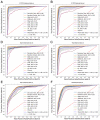Classification Models for COVID-19 Test Prioritization in Brazil: Machine Learning Approach
- PMID: 33750734
- PMCID: PMC8034680
- DOI: 10.2196/27293
Classification Models for COVID-19 Test Prioritization in Brazil: Machine Learning Approach
Abstract
Background: Controlling the COVID-19 outbreak in Brazil is a challenge due to the population's size and urban density, inefficient maintenance of social distancing and testing strategies, and limited availability of testing resources.
Objective: The purpose of this study is to effectively prioritize patients who are symptomatic for testing to assist early COVID-19 detection in Brazil, addressing problems related to inefficient testing and control strategies.
Methods: Raw data from 55,676 Brazilians were preprocessed, and the chi-square test was used to confirm the relevance of the following features: gender, health professional, fever, sore throat, dyspnea, olfactory disorders, cough, coryza, taste disorders, and headache. Classification models were implemented relying on preprocessed data sets; supervised learning; and the algorithms multilayer perceptron (MLP), gradient boosting machine (GBM), decision tree (DT), random forest (RF), extreme gradient boosting (XGBoost), k-nearest neighbors (KNN), support vector machine (SVM), and logistic regression (LR). The models' performances were analyzed using 10-fold cross-validation, classification metrics, and the Friedman and Nemenyi statistical tests. The permutation feature importance method was applied for ranking the features used by the classification models with the highest performances.
Results: Gender, fever, and dyspnea were among the highest-ranked features used by the classification models. The comparative analysis presents MLP, GBM, DT, RF, XGBoost, and SVM as the highest performance models with similar results. KNN and LR were outperformed by the other algorithms. Applying the easy interpretability as an additional comparison criterion, the DT was considered the most suitable model.
Conclusions: The DT classification model can effectively (with a mean accuracy≥89.12%) assist COVID-19 test prioritization in Brazil. The model can be applied to recommend the prioritizing of a patient who is symptomatic for COVID-19 testing.
Keywords: COVID-19; classification models; medical diagnosis; test prioritization.
©Íris Viana dos Santos Santana, Andressa CM da Silveira, Álvaro Sobrinho, Lenardo Chaves e Silva, Leandro Dias da Silva, Danilo F S Santos, Edmar C Gurjão, Angelo Perkusich. Originally published in the Journal of Medical Internet Research (http://www.jmir.org), 08.04.2021.
Conflict of interest statement
Conflicts of Interest: None declared.
Figures







References
-
- Elhoseny M, Abdelaziz A, Salama AS, Riad A, Muhammad K, Sangaiah AK. A hybrid model of Internet of Things and cloud computing to manage big data in health services applications. Future Generation Computer Syst. 2018 Sep;86:1383–1394. doi: 10.1016/j.future.2018.03.005. - DOI
-
- Chatterjee A, Gerdes MW, Martinez S. eHealth initiatives for the promotion of healthy lifestyle and allied implementation difficulties. International Conference on Wireless and Mobile Computing, Networking and Communications; October 21-23, 2019; Barcelona, Spain. 2019. pp. 1–8. - DOI
-
- Guimarães VHA, de Oliveira-Leandro M, Cassiano C, Marques ALP, Motta C, Freitas-Silva AL, de Sousa MAD, Silveira LAM, Pardi TC, Gazotto FC, Silva MV, Rodrigues V, Rodrigues WF, Oliveira CJF. Knowledge about COVID-19 in Brazil: cross-sectional web-based study. JMIR Public Health Surveill. 2021 Jan 21;7(1):e24756. doi: 10.2196/24756. https://publichealth.jmir.org/2021/1/e24756/ - DOI - PMC - PubMed
MeSH terms
LinkOut - more resources
Full Text Sources
Other Literature Sources
Medical

